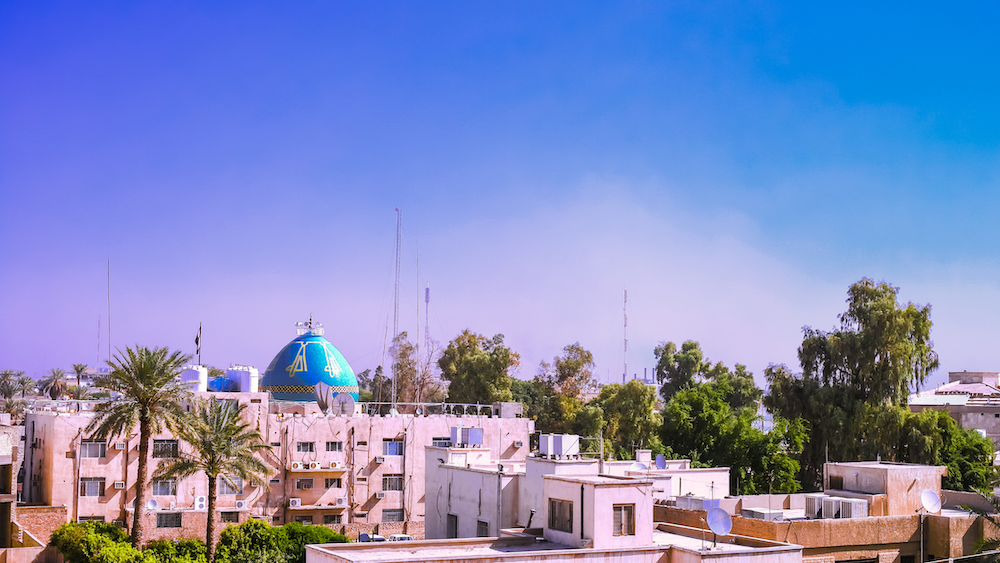In this series, we try to analyze why states in the Levant are still far from being democratic – and what responsibility foreign diplomats – especially Western diplomats – bear.
In the first part of this series, we saw how, at the beginning of the 20th century, European leaders divvied up what was previously the Ottoman Empire. In the process, they drew arbitrary borders that cut across ethnic, sectarian and religious lines, rendering a demographic make-up of these territories that isn’t exactly conducive to a united national identity. In the second part, we saw how Western governments and their diplomats both have created and supported autocratic regimes in the Levant – to the detriment of the people’s struggle for self-determination, using the example of Jordan.
In this third part, we’ll explore what happens when the international community – specifically the US government and partially the United Nations Security Council – do the opposite and topple autocratic regimes in the Levant, using the example of Iraq.
Toppling Saddam’s regime
In March 2003, a United States-led coalition invaded Iraq, with the aim “to disarm Iraq of weapons of mass destruction, to end Saddam Hussein’s support of terrorism, and to free the Iraqi people.” [1] A month after the first troops hit Iraqi ground, Bush declared the successful topple of Saddam’s regime. The latter, and the Arab Socialist Ba’ath Party he headed, had come into power following a military coup in 1968. Under his (majority Sunni) leadership, the Iraqi government committed vast numbers of crimes against Iraq’s primarily Kurdish and Shi’a populations.
Though it is undisputed that this invasion was illegal under the UN Charter, the U.N. Security Council later tasked occupying forces with “[the promotion of] the welfare of the Iraqi people, […] the restoration of conditions of security and stability and the creation of conditions in which the Iraqi people can freely determine their own political future.” The so-called “Coalition Provisional Authority” (CPA), created and funded as a division of the U.S. Department of Defense, vested itself with broad executive, legislative and judicial authority, effectively acting as Iraqi government for the period from April 2003 to June 2004.
The plan for a new state
The question of how to rule post-Saddam Hussein Iraq had been settled long prior to the invasion. In fact, the regime’s opponents that had been exiled from the country – majority Shi’a, as part of the oppressed group – had been planning for a new state for decades. They believed that justice would be served by a new state order that reflected the “actual” religious and ethnic make-up of Iraqi society: “Shi’a Arabs representing 55% of the population, Sunni Arabs 33%, and Kurds 19%”.
Thus, during the so-called “transitional period” – meaning moving from US rule to fully Iraqi rule – the advisory councils and provisional governments were all chosen based on these sectarian quotas. Strategically speaking, for the newly returned political elite – devoid of any real indigenous support base, political platform, or power – sectarianism offered an attractive means of legitimization for the marginalized and oppressed of the Saddam regime.
Most importantly, this meant that the first political parties to participate in the new Iraqi democracy fused along ethnic and sectarian lines to define their constituencies: United Iraqi Alliance for the Shia population and Democratic Patriotic Alliance of Kurdistan for the Kurdish population. For the Sunni population, however, representation was made a lot more complicated by the CPA’s so-called “de-Baathification” policy: the purging of the administration of tens of thousands of civil servants, ranging from political elites to primary-school teachers – all based on Ba’ath Party affiliation (meaning all those that worked in the public sector under Saddam’s regime) rather than on actual conduct.
Sectarism and the muhasasa
In the first decade after the invasion, instead of engaging in issue-based rhetoric, the new ruling elites fired up decades-old divisions between Shi’a, Sunni and Kurdish groups, fueling the Iraqi civil war of 2006-2007 and firing up more hatred during the Arab Spring and the Syrian Civil War.
Even when secular political factions attempted to enter the political arena, with a message of equal citizenship for all and a replacement of the sectarian politics that had driven the country into civil war, the ruling elite used de-Ba’athification legislation to discredit and ban a large number of its (Sunni) candidates from participating in elections.
Crucially, sectarian parties were able to cement their newly acquired dominance over the state through the so-called “muhasasa” (translated as “quotas”). Muhasasa has two components. First, it refers to the repartition of certain positions to particular sects, with a Kurdish President, a Shi’a PM and a Sunni Speaker of Parliament. Second, it refers to the divvying up of state institutions among the parties within the larger ethno-sectarian blocs. After every election, there are ferocious battles for control of ministries, where the largest prizes, such as the Ministries of Oil, Transport, and Electricity, usually go to the most powerful parties. Some parties have even “colonized” particular ministries in Baghdad and are seen as “owning” the institution.
Even worse, over time, all major parties have affiliated with militias to protect their interests. These militias originally filled the void created by the CPA’s disbanding of the Iraqi army and police, forming a de facto security sector. Now that they’ve affiliated with a party, they are used to intimidating journalists, protesters, and other political opponents.
The “partytocracy” – why Iraq isn’t even close to being democratic
Over time, as sectarian divisions ingrained themselves in the system and gained wider acceptance in the political landscape, dynamics have shifted: Unconcerned with genuine political constituencies, party apportionment is now overtly about the division of spoils among unrepresentative political actors. In fact, recent research on party organizations shows a trend toward oligarchic leaders who collude – rather than compete – with other parties, dubbed a “partyocracy”. In the face of public pressure, the previously divided political elite has united against the common threat to the status quo: the people.
The various grievances of the Iraqi people towards their government have been brought to light repeatedly through popular protests starting in 2011, continuing in 2015, and culminating in the greatest protests to date in 2018 and 2019.
Most of the protesters were under 30 years old and had grown up in a country ravaged by sectarian wars, lacking infrastructure and public goods, and where state institutions are structured by corruption and nepotism. Hence, these youth rejected Islamism and identity-based political formation entirely. In response, the threatened partyocracy made every effort to thwart and discredit the protests. Reports also suggest that the parties deployed their militias to intimidate, beat, and humiliate protesters.
Conclusion
From the very beginning, the Iraqi people did not trust the new political elite. Firstly, they were tainted by their association with the U.S. invasion and its dubious justifications. Secondly, since many had long lived outside of Iraq, they were seen to be out of touch with the country’s current reality. And thirdly, though the CPA saw them as potential intermediaries between the international administrators and the Iraqi staff, the new elite’s lack of administrative experience made them extremely poor managers.
To summarize, in Iraq, democracy was forcefully imposed by foreign powers. Though their involvement did bring about many necessary constitutional changes for Iraq, Iraq is nowhere near what the international community had anticipated Iraq would look like once they would “bring democracy.” Instead of “returning” the government to the people, old corrupt leaders have been replaced with equally corrupt leaders. In addition, regional instability has provided the momentum for foreign-backed paramilitary groups to infiltrate – and even dominate – today’s political landscape.
US (and to a lesser degree, UN Security Council) diplomats not only did not free the Iraqi people by toppling Saddam’s autocratic regime but created a whole new monster of an institutionalized oppressive multi-party regime that has turned on its people. This whole process not only cost the Iraqi people 20 years of instability, war, corruption and poverty but might possibly have even prolonged the road to peace and self-determination by a long shot.
Sources :
[1] “President Discusses Beginning of Operation Iraqi Freedom”, President’s Radio Address, transcript released on March 22, 2003.
Human Rights Watch, “Justice for Iraq: A Human Rights Watch Policy Paper”, (December 2002).
“President Discusses Beginning of Operation Iraqi Freedom”, President’s Radio Address, transcript released on March 22, 2003.
“Excerpts: Annan Interview”, BBC News (16 September 2004).
“Mission Accomplished Speech”, a televised address on the aircraft carrier U.S.S. Abraham Lincoln on 1 May 2003.
United Nations Security Council (UNSC) Res. 1483 (22 May 2003) UN Doc S/RES/1483.
Marten Zwanenburg, “Existentialism in Iraq: Security Council Resolution 1483 and the law of occupation”, International Review of the Red Cross Vol. 86, no. 856 (December 2004): 765-766.
United Nations Security Council (UNSC) Res. 1511 (16 October 2003) UN Doc S/RES/1511.
Toby Dodge and Renad Mansour, “Sectarianization and de-Sectarianization in the Struggle for Iraq’s Political Field”, The Review of Faith and International Affairs Vol. 18, no. 1 (2020): 61.
Zahra Ali, “From Recognition to Redistribution? Protest Movements in Iraq in the Age of ‘New Civil Society'”, Journal of Intervention and Statebuilding (26 March 2021): 3.
Charles Clover, “Iraq to Get Interim Council Later this Month”, Financial Times (8 July 2003).
Constitution of the Republic of Iraq of 2005
Mieczyslaw P. Boduszynski, “Iraq’s Year of Rage”, Journal of Democracy Vol. 27, no. 4 (October 2016): 113-116.
Charles Clover, “Shia Look to Dominate Iraqi Parliament”, The Financial Times (3 November 2004).
Toby Dodge, Iraq: From War to a New Authoritarianism (Abingdon, Oxon: Routledge, 2012): 215.
Haddad Fanar, “From Existential Struggle to Political Banality: The Politics of Sect in Post-2003 Iraq”, The Review of Faith & International Affairs Vol. 18, no. 1 (2020): 75.
Khalid Al-Ansary, “Thousands rally in Iraq’s “Day of Rage” protests”, Reuters (25 February 2011).
Zahra Ali, “From Recognition to Redistribution? Protest Movements in Iraq in the Age of ‘New Civil Society'”, Journal of Intervention and Statebuilding (26 March 2021): 4.
Sarwar Mohammed Abdullah, “Corruption protection: fractionalization and the corruption of anti-corruption efforts in Iraq after 2003”, British Journal of Middle Eastern Studies Vol. 46, no. 3 (2019): 359.
Richard S. Katz and Peter Mair, “Changing Modes of Party Organization and Party Democracy: The Emergence of the Cartel Party,” Party Politics Vol. 1 (January 1995): 5-28.
Miranda Sissons and Abdulraqqaz Al-Saiedi, “A Bitter Legacy: Lessons of De-Baathification in Iraq” International Center for Transitional Justice (March 2013).
Beth K. Dougherty, “De-Baathification in Iraq: How Not to Pursue Transitional Justice”, Middle East Institute (30 January 2014).
Renad Mansour, “More Than Militas: Iraq’s Popular Mobilization Forces Are Here to Stay”, War on the Rocks (3 April 2018).
Haddad Fanar “The Waning Relevance of the Sunni-Shia Divide”, The Century Foundation (10 April 2019).
Erin Cunningham and Mustafa Salim, “Iraq’s Shiites helped boost the political elite in Baghdad. Now they want to bring it down.”, The Washington Post (29 December 2019).
Simona Foltyn, “They are worse than Saddam’: Iraqis Take to Streets to Topple Regime”, The Observer (27 October 2019).
UNAMI, “Demonstrations in Iraq, 1-9 October 2019” Human Rights Special Report (22 October 2019).
UNAMI, “Demonstrations in Iraq Update’, 25 October – 4 November 2019” Human Rights Special Report (5 November 2019).

